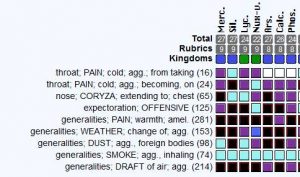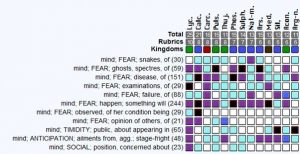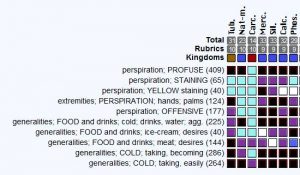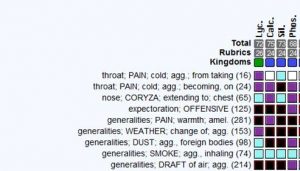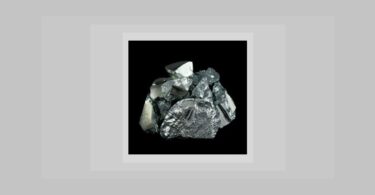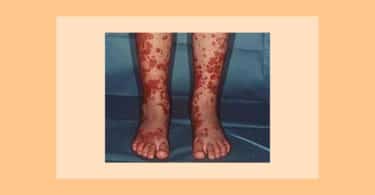A male patient, 29 years of age, residing in the central suburbs of Mumbai, consulted Dr. Rishi Vyas, an In-house Consultant and Faculty at ‘the other song’ on 22nd June, 2013 for recurrent tendency to develop cold and cough over the past 10 years. He was a K/C/O of asthma and had to use bronchodilator inhalers at frequent intervals to control his breathlessness. The case is edited for brevity and grammatically altered for better comprehension.
The patient’s complaints were generally brought on by exposure to cold air, eating/drinking cold food or change in weather. He was also allergic to strong odours, draft of air and dust. The typical episode began with constant sneezing followed by head pain, soreness of throat with difficulty in swallowing, all this ultimately culminating in fever, which was low grade and was accompanied by fatiguing sensation in lower limbs. There was dullness, drowsiness, body ache, more of knee and ankle joints with fever, especially following consumption of antibiotics. Besides, he also experienced a stitching type of pain in the throat which was aggravated when swallowing, eating/drinking cold food and drinks and better by having warm liquids. He had offensive expectoration often with a putrid taste in his mouth. The patient had been resorting to antibiotics on and off and had also seen several doctors without any significant relief.
Emotionally the patient felt very low during the episodes and was averse to any work. The illness affected his routine in many ways keeping him away from simple but necessary tasks like regular exercise. Besides, it adversely affected his work performance several times as it rendered him incapable of accomplishing tasks at work and delivering them on time, thus failing to meet the expectations of people around him. After every episode of illness, his incomplete work just kept piling higher. As a result, he was always under the pressure of completing all his work in a deadline and this pressure kept on building till a time when he felt he would burst of it.
The patient felt that for him everything came together onto him at one time, such as issues about health, work and family, and he felt completely incapable of handling them. He described the outcome of this as a series of emotions cascading within him; anger – that he could meet the expectations of only a few, followed by disappointment and sadness. He cited an example where he was unable to attend a family wedding since he was exhausted after work. When asked about his experience in that situation he said, he felt incomplete and incapable as he couldn’t meet expectations. He also felt that every time he extended his boundary beyond his limits, the expectations from others also increased and eventually he could not again meet them. There was deep disappointment within him with a persistent want of managing time and situations better.
When asked about his nature, he said he enjoyed listening to music and watching educational programs. He aspired to be successful, have a good income and have good social standing. He always felt the need to do and achieve more than he was able to currently and strived to meet the standard that his superiors had set at work. He wanted to grow in his career and according to him the only way he could achieve that was by performing better and better, by pushing his limits and being innovative. If he was able achieve this, he would be promoted and would have a better income which would help him improve the standard of living and help him pay off his loan. He was sensitive about being hurt by people and was adversely affected when people pushed him to do things which he did not want to do.
He was quite patient by nature, but occasionally he would strike someone if he lost patience. Most of the time he tried to control his anger, as he was afraid that if he got into a fight with someone, there would be issues in acquiring a Visa and he would not be able to leave the country. This would mean a bad name and he did not want any ‘Spot’ on his ‘Name’ or reputation. He felt it was important to maintain his ‘image’ in society as it takes long for an individual to build it and he did not want that ‘image’ to collapse.
The patient was always anxious about several things. Recently, he was worried about the loan that he had drawn from and was always worried if he would be able to pay his dues on time. His current worry was about a home loan he had borrowed and wondered if he would be able to pay the dues on time. He was planning to start his family and was much concerned about expenditures and ways to minimize them. His other anxieties included his upcoming appraisal at work, new assignment and changing the job, his health and his father’s health (his father had a problem walking).
When asked about his childhood, he said he was mischievous and playful. He was fond of cars and was fascinated by them. He also enjoyed eating ice-cream a lot. As a child, he feared darkness and snakes. He also had tremendous fear of examinations, which were a ‘nightmare’ to him. His main fear was failing at math as he was very weak at it. He was afraid of speaking in public and so would be very anxious before any presentation. He was nervous when people looked at him and would go blank. He dreamt mainly of travelling, snakes and ghosts. He also feared ghosts and named a few movies which terrified him.
The patient relished sweets, chicken and fish. He had great thirst for water and could tolerate hunger well. His head complaints were better by sleeping. He was generally constipated but had a history of severe diarrhea in childhood. He had staining perspiration which was also cold, clammy and profuse especially on his palms. He could not tolerate cold weather and was very sensitive to it. He perspired a lot before presentations and was worried about what his colleagues would think about him.
On examination, his palms were moist and finger tips were cold to touch. He also had a bluish tinge on his gums.
Analysis of the case:
The primary aim of homoeopathic case-taking is to individualize a person and so it is always aimed at eliciting the characteristics which can help analysis for a simillimum. The characteristics lie at many levels and help the homoeopath understand the person at two levels – at the level of facts, that is the symptoms he presents with and the other being at the level of understanding who he is as a person. In order, to understand and enrich our analysis, there are approaches, which help understand the person’s innermost experience, his core feeling or his sensitivity. This understandings when synergistically complemented help arrive at a conclusion in the form of a prescription which is more definite.
In the above case too, there was an attempt to understand the characteristic symptoms at all levels described above through both the physical and the emotional channels. The first step was to note and classify all the peculiar symptoms as characteristic. In this case, we can see a characteristic pattern in the illness. The patient exhibits a peculiar sequence of events in his chief complaint. His complaints begin from exposure to cold, draft of air or dust leading to sneezing, followed by headache, soreness of throat, cough with offensive expectoration resulting in bronchitis and bronchial asthma. This phenomenon is characteristic to the patient and hence individualizing and has to be a part of the remedy selected. On converting these physical symptoms into rubrics we get:
Rubrics:
- Throat; pain; cold; agg.; from taking (16)
- Throat; pain; cold; agg.; becoming, on (24)
- Nose; coryza; extending to; chest (65)
- Expectoration; offensive (125)
- Generalities; pain; warmth; amel. (281)
- Generalities; weather; change of; agg. (153)
- Generalities; dust; agg., foreign bodies (98)
- Generalities; smoke; agg., inhaling (74)
- Generalities; draft of air; agg. (214)
(Complete Repertory, copyright @Roger van Zandvoort, from MacRepertory 8.2.01, Professional)
We can see remedies like Merc Cor, Silica, Lycopodium, Nux Vomica, Arsenic album, Calcarea, and Phosphorous coming up on repertorization.
Now let us perceive the case in a deeper manner in order to understand the underlying state of the patient. There are several exciting and maintaining factors which are stressful to the patient. He was worried about paying off his home loan, managing a busy work schedule, maintaining health, fulfilling commitments at home, health and family planning. In this situation, he felt incapable and found it difficult to cope, which eventually led to disappointment.
Another aspect of the patient’s personality was his need to acquire a ‘Name’ and a good social position in society. The patient also wanted to grow in his career and profitability at work. In order achieve that, he felt the need to improvise on his skills. In situations where the patient has to give a presentation before his colleagues, he experienced a lot of anxiety and nervousness. This tells us that the patient was a nervous, anxious and timid individual who is very ‘Image Conscious’. He is also very fearful and fears dark, ghosts and snakes.
When considered as symptoms, they give us the following rubrics:
Rubrics:
- Mind; fear; snakes, of (30)
- Mind; fear; ghosts, spectres, of (59)
- Mind; fear; disease, of (151)
- Mind; fear; examinations, of (29)
- Mind; fear; failure, of (88)
- Mind; fear; happen; something will (244)
- Mind; fear; observed, of her condition being (29)
- Mind; fear; opinion of others, of (21)
- Mind; timidity; public, about appearing in (65)
- Mind; anticipation; ailments from, agg.; stage-fright (48)
- Mind; social; position, concerned about (23)
(Complete Repertory, copyright @Roger van Zandvoort, from MacRepertory 8.2.01, Professional)
In the above chart, we can see Lycopodium, Calcarea, Carcinosin, Pulsatilla, Thuja, Phosphorous, Sulphur , Natrum Mur, Medorrhinum and Silica coming up on repertorization.
Now taking into account the patients physical general symptoms and tendencies we get:
Rubrics:
- Perspiration; profuse (409)
- Perspiration; staining (65)
- Perspiration; yellow staining (40)
- Extremities; perspiration; hands; palms (124)
- Perspiration; offensive (177)
- Generalities; food and drinks; cold; drinks, water; agg. (225)
- Generalities; food and drinks; ice-cream; desires (40)
- Generalities; food and drinks; meat; desires (144)
- Generalities; cold; taking, becoming (286)
- Generalities; cold; taking, easily (264)
(Complete Repertory, copyright @Roger van Zandvoort, from MacRepertory 8.2.01, Professional)
On combining all the Rubrics we get:
Rubrics:
Throat; pain; cold; agg.; from taking (16)
Throat; pain; cold; agg.; becoming, on (24)
Nose; coryza; extending to; chest (65)
Expectoration; offensive (125)
Generalities; pain; warmth; amel. (281)
Generalities; weather; change of; agg. (153)
Generalities; dust; agg., foreign bodies (98)
Generalities; smoke; agg., inhaling (74)
Generalities; draft of air; agg. (214)
Mind; fear; snakes, of (30)
Mind; fear; ghosts, spectres, of (59)
Mind; fear; disease, of (151)
Mind; fear; examinations, of (29)
Mind; fear; failure, of (88)
Mind; fear; happen; something will (244)
Mind; fear; opinion of others, of (21)
Mind; timidity; public, about appearing in (65)
Mind; anticipation; ailments from, agg.; stage-fright (48)
Mind; social; position, concerned about (23)
Perspiration; profuse (409)
Perspiration; staining (65)
Perspiration; yellow staining (40)
Extremities; perspiration; hands; palms (124)
Perspiration; offensive (177)
Generalities; food and drinks; cold; drinks, water; agg. (225)
Generalities; food and drinks; ice-cream; desires (40)
Generalities; food and drinks; meat; desires (144)
Generalities; cold; taking, becoming (286)
Generalities; cold; taking, easily (264)
(Complete Repertory, copyright @Roger van Zandvoort, from MacRepertory 8.2.01, Professional)
In all the above repertorization charts, we can see Calcarea and Silica coming up prominently. From our reference literature of Calcarea from the source books, we find that a Calcarea carbonicum has multiple fears like that of darkness, ghosts, animals, dogs, infections, disease, alone, snakes, injury, insects etc. On the other side, Silica has symptoms such as ailments from anticipation, fear of failure, stage fright, fear of examinations, timidity appearing in public.
Now, if we are to see the case using the Sensation Approach, we see that the patient wants to do many things and fulfill the expectations set by himself and others, but he feels incapable and it’s difficult to cope with the situation. This is the experience of the mineral group of remedies where the patient either feels a lack, incapability or tries to gain/maintain his structure in order to complete himself. Further, we see that his issues are more to do with work, finance, health, family, routine. All these are issues which indicate security for a person, which belong to the 4th row of the periodic table. Calcarea carbonicum, belonging to left side of the 4th Row of the periodic table has a feeling of lack, incapacity to carry out the required function of that particular row – which is to protect himself.
In this case there are also issues to do with timidity appearing in public, stage fright, conscious of one’s appearance/image in society. These are the peculiar qualities of Silica belonging to the 3rd Row of periodic table where the main issues are about Identity, Love, Care and Nourishment.
So, on one hand, we see all the symptoms pointing to a remedy and on the other hand we have the knowledge from the Sensation backing up the prescription. Isn’t this preferred and does this not lend more confidence to any physician, when all the approaches traditional and recent point to the same remedy? And to further confirm our prescription, it is always wise to back it up with sound references from our literature. The references taken for this case were as follows:
Reference from Kent’s lectures of Materia Medica:
Calcarea Silicata [Calc-sil.]
The Silicate of lime is a very deep-acting remedy. The symptoms come on during all parts of the day and night – morning, forenoon, afternoon, evening, night, after midnight. It acts profoundly upon the skin, mucous membranes, bones and glands. Abscesses, catarrhal discharges, ulcers, are marked with thick, greenish-yellow pus. Thick greenish-yellow expectoration. Aversion to the open air. Extreme sensitiveness to drafts. Marked paleness as in anemia. Weakness and out of breath ascending stairs, like Calcarea. It has cured epithelioma and lupus. From what is known of both Calcarea and Silica it ought to be a remedy in caries where the symptoms agree. Change of weather, from warm to cold, makes all symptoms worse.
Anxiety in evening in bed and during the night about her health, worse during menses and on waking in the morning. Wants many things and soon tires of them; desires the unobtainable; nothing suits and he is very critical. Inability to concentrate the mind on what he is reading or listening to. He has lost all confidence in himself.
Dr. Sankaran mentions in ‘The Soul of Remedies’– Calcarea Silicata is a salt and represents a combination of feelings of both Calcarea and Silica. Like Calcarea the person feels insecure, with the need for protection and like Silica he feels the need to maintain a particular standard. Hence the feeling of Calcarea Silicata is, “I need to keep up to a particular standard to get the security and protection I need.”
Reference from Substance of Homeopathy:
It represents a combination of feelings of both Calcarea and Silica. Like Calcarea he feels insecure and feels the need for protection from external harm. Like Silica he feels the need to keep up a particular standard. When these two feelings combine we have a unique feature of Calcarea Silicata namely “I need to keep up to a particular standard to get security and protection which I need”. This gives the symptom “Sensitive to reprimands”. A person is reprimanded by an authority or his superior when he falls short of the standard set for him by that superior. The sensitivity to reprimands represents the need of Calcarea Silicata to maintain the standard which the superior sets for him. In the third stage the Calcarea Silicata is a shy, bashful, timid extremely nervous personality, very fearful and especially timid to appear in public. He has a lot of anticipatory anxiety before exams, interviews, meeting people or before beginning a new job. There is severe anxiety about health, often with severe hypochondriacal manifestations. There is also a lot of anxiety about money matters. He is irresolute, hesitant, mild and yielding. The dreams are of anxiety, insecurity and they can also have pleasant dreams of being with their family or talking to dead relatives. They are physically lean, chilly, have sweaty palms and soles, especially cold sweaty finger tips, blue line on the gums, suppurative problems like sinusitis or bronchitis with yellowish, offensive discharges.
Calc sil has “Anxiety about health” and “utterly ambitionless” on one side while on the other, it also has “hurried”, impatient and “anticipatory anxiety”. The patient feels incapable of performing and gives poor health as an excuse for not being able to perform but at other times he somehow tries to live upto the expectations.
This phenomenon is exactly seen in this patient. He mentioned several times about maintaining social status and his position in society, security in terms of his job and money, not being able to live up to the expectations of the job and family. He was also much concerned about what others had to say about him.
One of the confirmatory symptoms of this remedy found by Dr. Sankaran verified clinically in his practice is ‘coldness of the finger tips’ and ‘blue lines on gums’
Other symptoms suggestive of Calcarea Silicata are:
- Fear disease, incurable of being
- Fear poverty
- Fear work, dread of
- Delusion voices, hears and answers.
- Delusion talking dead people with
- Cowardice
- Irresolution
- Timidity bashful
- Sensitive, reprimands to
- Yielding disposition
- Suppurative problems like sinusitis, bronchitis with offensive discharge.
On the basis of the available homeopathic literature and our understanding of Materia Medica, the patient received Calcarea Silicata 1M ad4bd2 followed by Cosmos 30 for a month.
The patient did progressively well, with very few episodes of allergic cold. He repeated a single dose of Calc Silicata as and when required. Given below is his latest follow up and a brief summary of his health in the two years of his treatment.
Follow up dated 8-09-15:
D: Doctor, P: Patient
D: How are you doing now?
P: I am fine now. I had an episode of loose motion yesterday. There was cough and fever last week which got better by dose of SP1 (SP1 – Calcarea Silicata 1M)
D: How is your sleep?
P: Sleep is good. There is mild soreness in the throat. Overall I am okay. Perspiration is also less.
D: From the time you have started treatment, what are the changes you have seen?
P: The frequency of taking antibiotics has reduced to a great extent. Earlier I caught infection easily but that is not the case now. My anxiety levels have come down and so has my jitteriness before meetings and presentations. I feel more settled now. I feel calm and composed. At work, I am more productive. Majorly I was suffering because of that.
D- Overall what is the level of improvement on a scale of 1-10?
P- It is 7/10.
About the other song:
About ‘the other song: International Academy of Advanced Homoeopathy’: ‘the other song’ is a world class premier medical centre which puts good health and well being at the core of an academic culture dedicated to complete patient care. Situated in Mumbai, this institute is one of a kind where a team of 35 doctors headed by Dr. Rajan Sankaran (the pioneer of the Sensation Approach in Homoeopathy) come together and practice Homoeopathy. At the Academy, the students and practitioners are trained in advanced Homoeopathic practices, using new methodologies in combination with the traditional approaches, all with the use of state-of-the-art technologies. The Academy is also a meeting point for different schools of thought in Homoeopathy, where renowned homoeopaths – national and international are invited, to share their knowledge and experience, so that there is a constant flow of ideas on a common platform. http://theothersong.com/


